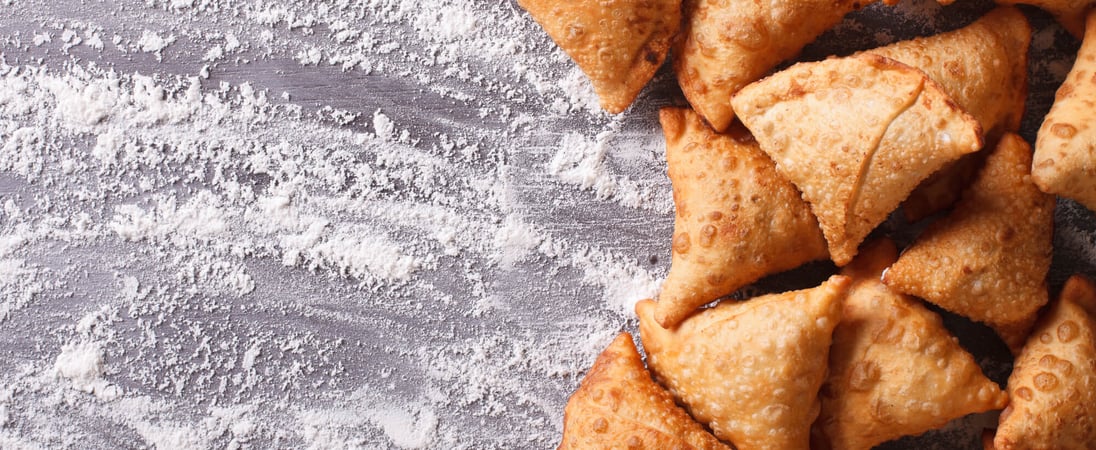
World Samosa Day
Learn how to make the delicious stuffed, spiced, fried appetizer known as a samosa yourself, or get some Indian food to enjoy some professionally made ones.
Never hurt a Samosa’s feelings by telling it no. They too have fillings inside.
Unforgivably bad pun
If you’ve never had one of these delicious little pockets of goodness, you’re certainly missing out. Here is the first and most important thing you need to know about Samosas: they are a delightfully fried dish filled with onions, peas, potatoes, cheese, beef or lamb, or any of a myriad of other fillings.
Samosas have become increasingly popular in the US, and World Samosa Day encourages you to try them out if you’ve never had them, no matter where you’re from. Let’s take a look at the history of these delicious little pouches of culinary love!
How to Celebrate World Samosa Day
Getting involved with World Samosa Day can be loads of fun! Try out these ideas for celebrating or come up with some of your own:
Eat Some Delicious Samosas
World Samosa Day is best celebrated by indulging in these delicious fried foods. Their flavor is incredible and there is little else that is as satisfying as biting into a warm samosa and feeling the delicious fillings settling in your stomach comfortably.
Many people find the seasonings used to be particularly agreeable, and think that samosas are the perfect addition to almost any meal.
Learn How to Make Samosas At Home
This deep-fried pastry with spicy filling really isn’t that difficult to make. Start by boiling the potatoes. While they are cooking, make the dough using all-purpose flour, caraway seeds, and some oil.
Mix up the dough with your hands for several minutes, until it resembles coarse breadcrumbs (the same as for making a pie crust). Form a ball out of the dough and let it rest for 30 minutes before rolling it out.
In the meantime, cook up the spices in some oil, including whole cumin, ginger, and diced green chiles. At this point, the option of adding chopped cashews to the recipe can be a fun one!
Now, get ready to add the spices, such as chili powder, garam masala, cumin powder, salt, fennel powder, and other optional spices according to taste.
Once the dough is chilled, knead it, divide it into separate portions and then roll it out into circles. Cut the circles in half, roll them into cones, fill, and close up the edge. The trick to getting the dough to stick to apply water to the edges to create a seal.
Deep fry them in hot oil and then get ready to enjoy delicious, homemade samosas!
Throw a Samosa Party
Grab some friends, neighbors, coworkers or family members and gather together to have a party that is completely dedicated to celebrating Samosa Day!
Of course, the theme should be around the idea of Samosas, with decorations, music and even costumes that honor the cultural history of this tasty little treat, perhaps from India or Pakistan.
Of course, the main food served would need to be Samosas of all varieties and flavors. In fact, guests could possibly even have the pleasure of making the food.
In addition, dessert samosas should certainly be on the menu. Try sweet fillings such as cinnamon cheesecake, mango, or Nutella and coconut. A delicious way to end a Samosa Day party with something delightfully sweet for the palate.
Whether they are preferred when prepared hot and spicy, small and mellow, or large and in charge, World Samosa Day is just the perfect opportunity to indulge in all of those delicious options for flavors. Now get out there and eat them all!
History of World Samosa Day
Samosas find their origins somewhere in the Middle East, and historians estimate that this was at some time prior to the 10th century.
At some point a few hundred years later, during the 13th or 14th century they were brought by traders to India, where it quickly became an incredibly popular food.
To this day Samosas can be found in family homes, at fancy or casual restaurants, and even from roadside vendors where they are fried fresh in vegetable oil.
Their shell is prepared using wheat or maida flour, and they are then stuffed with a traditional mashed potato, onions, green peas, and various regional spices that make it absolutely delicious. To make it even more perfect, vendors tend to serve it with a bit of mint, coriander, and tamarind.
These tasty treats have become particularly enjoyable during the month of Ramadan, the religious observation of Islam.
Interestingly, if for those who are wanting a spicier rendition of the Samosa, they shouldn’t actually go to India. Instead indulge in a Pakistani-inspired blend of ingredients.
In Pakistan, Samosas are primarily filled with vegetable ingredients, but the locals enjoy them with a particularly vibrant punch of spices, especially in the southern Sindh province or Eastern Punjab.
Of course, Pakistan is also the place to go for those who enjoy Samosas so much that they want them in jumbo size! In this case, it’s necessary to stop over in Faisalabad, where they are made in what are considered unusually large sizes.
However, the absolute largest Samosa in the world that set the Guinness World Record in 2017, weighing in at 153 kg (335 pounds), was made in a London mosque as a way to bring awareness to a charity. Now that’s one way to celebrate World Samosa Day!
World Samosa Day FAQs
Did samosas originate in India?
No. Samosas originally came from the Middle East and Central Asia, where they were called “sambusak” or “sanbosag.”
Traders and travelers carried them along the Silk Road, spreading the snack to Persia, Africa, and eventually India.
Unlike today’s deep-fried version, early samosas were baked and filled with meat, nuts, and spices.
They arrived in India around the 13th-14th century, where they evolved into the spicy, potato-filled snack loved today.
What’s the biggest samosa ever made?
The world record for the largest samosa goes to a group in the UK, who made a 153.1 kg (337 lb) samosa in 2017!
It was cooked in a giant deep fryer and filled with potatoes, onions, and spices. The idea behind the attempt was to raise awareness for food waste, as all the samosa portions were later given to those in need.
Do all samosas have a triangular shape?
Not at all! While the triangular shape is the most famous, different cultures have their own versions:
- Somali samosas (Sambusa) are usually smaller and crescent-shaped.
- Tajik and Uzbek samosas are often round or square, baked instead of fried.
- Mauritian samosas are mini-sized with sharper edges and are typically vegetarian.
What’s the strangest samosa filling ever made?
Chefs around the world have experimented with weird and unexpected fillings. Some of the most unusual include:
- Nutella & Banana Samosa – A sweet take from France.
- Mac & Cheese Samosa – Popular in some American fusion restaurants.
- Octopus Samosa – Found in a few Japanese-Indian fusion spots.
- Kangaroo Meat Samosa – Served in parts of Australia as a novelty dish.
Why was the samosa once considered “elite” food?
In medieval India, samosas were a dish for royalty and the wealthy.
Historians note that it was served in the Delhi Sultanate court (13th-16th century).
The Sultan’s chefs would stuff them with exotic meats, dry fruits, and precious saffron. Eventually, as potatoes became common in India (thanks to Portuguese traders), samosas became affordable street food.
What’s a common misconception about samosas?
Many people assume samosas must be deep-fried, but baked samosas are just as traditional.
In places like Uzbekistan, Afghanistan, and Iran, people still bake samosas in clay ovens (tandoors) instead of frying them. These samosas have flakier, crispier crusts, much like a puff pastry.
How do people celebrate World Samosa Day in unexpected ways?
Some countries go beyond just eating samosas and celebrate in creative ways:
- Kenya & Tanzania – Some families host cooking contests to see who can make the most unique samosa flavor.
- Pakistan – Bakeries offer “Jumbo Samosas”, which are as big as a pizza slice.
- Canada – Indian restaurants often run “Samosa Happy Hours”, where each samosa costs just a few cents.
- Dubai – Some spots host “Samosa Speed-Eating Competitions”, where people try to eat as many as possible in one minute.
What’s the fastest time to eat a samosa?
A British competitive eater, Leah Shutkever, holds the record for eating a standard-sized samosa in just 8.02 seconds!
Competitive samosa-eating is growing in popularity, with contests held in India, the UK, and Dubai.
Why do some people avoid samosas?
While samosas are widely loved, some groups avoid them for various reasons:
- Somalia banned them in 2011 when the extremist group Al-Shabaab claimed the triangle shape resembled a Christian symbol.
- Some health-conscious eaters avoid deep-fried samosas due to their high oil content.
- Strict vegans check ingredients carefully, as some samosa dough contains ghee (clarified butter) instead of plant-based oils.
Can you make a samosa without dough?
Yes! Some creative home chefs and restaurants have ditched traditional dough for unique alternatives:
- Rice Paper Samosa – Used in some Vietnamese fusion dishes.
- Noodle-Wrapped Samosa – A crunchy twist using fried noodles as a crust.
- Lettuce-Wrapped Samosa – A low-carb alternative served in some health-conscious eateries.
- Cheese-Wrapped Samosa – Instead of dough, chefs wrap the filling in melted, crispy cheese.
See what else is happening…
There’s always more going on every month at Days Of The Year. Here are our favorites this month!
Also on ...
View all holidaysNational Cheese Pizza Day
When it comes to satisfying your pizza cravings, nothing hits the spot quite like a warm, gooey slice of cheesy goodness.
National Lazy Mom’s Day
Parenting is a demanding job, but it's okay to take a break. Resting and practicing self-care can recharge and make you a better parent.
International Day of Charity
Any charitable donation, big or small, money or time, can go a long way to helping solve some of the world’s worst problems, such as child hunger or the environment.
National Chianti Day
Savoring this rich, velvety red with deep flavors and aromatic complexity enhances any meal or celebration beautifully.




